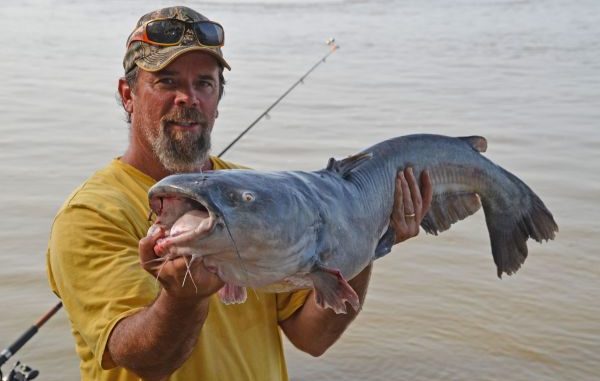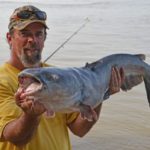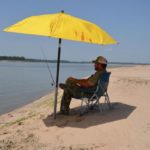
If you’re not quite ready to hit the woods for the hunting season, the Mississippi River can provide plenty of catfishing action. Learn how these big-cat hunters fill their freezers.
It looked like a sea monster when it first came up.
The wide, slate-gray body did a rolling churn when it surfaced in the turbid Mississippi River water.
This was good!
On some trips, things just seem to go right. It started the day before. I could smell the barbecue a half mile before I got to the Danley home.
I’ve always said, “If you ain’t never et a real redneck ‘bobby-que,’ you ain’t et nothing good yet.”
The pit was honest-to-gosh overflowing — steaks, smoked sausage, pork chops, and ribs.
Presiding over it all was Big Jim Danley, bearded, wearing bib overalls and a welcoming smile, and waving a set of tongs.
Inside the house, his wife Kim was in charge of spreading the fixin’s: barbecue beans, corn, potato salad, mac-and-cheese, and hot bread.
I thought that I had died and gone to heaven.
I hunted these folks down in the flat lands of Delta country because I had heard of a 12-year-old boy — Lawson Boyte — setting a new Louisiana state record for blue catfish with a 114-pound monster.
The youngster is Danley’s nephew. Danley has a son of almost the same age named Bo, and the two cousins are together so much they are more like brothers than cousins.
“I take them hunting and fishing as much as I can,” the elder Danley beamed. “We go camping a lot on (Mississippi River) sandbars. We set up a tent and spend the night. We fish, and we cook fish.”
Danley has been bringing the pair fishing and hunting with him since they were 6 years old.
“I like fishing, and I like being on the bank,” Bo chimed in.
The next day the two boys spent far more time exploring the big river’s banks than sitting in a boat and fishing.
“That’s mostly what they like to do,” Jim Danley grinned knowingly.
Daylight the next day found us at the Rockpile Boat Launch. In one of those Louisiana-Mississippi border anomalies (more about those elsewhere), the road to the launch and the launch itself are in Louisiana, but the water into which the launch projected was all Mississippi.
Known variously as Bunch’s Chute or Bunch’s Cutoff (Danley simply calls it Rockpile Chute) the ancient, tree-fringed, abandoned Mississippi River channel opened directly into the present river bed on its eastern end.
Both Danley and buddy Scott “Pod” Lewis were in aluminum johnboats. Danley’s was a 15-foot Duracraft and Lewis’ was a Weldbilt. Powered by 40-horse outboards, the pair quickly ran the 3 ½-mile length of the chute to the main body of the Mississippi River itself.
From there, they headed downstream and pulled up on the eastern bank of the river, one boat behind the other.
The youngsters quickly hopped out of the boats and tied the bow ropes to the limbs of a fallen tree. Danley silently scrutinized the river’s water for a few minutes, to verify the had stopped in a good spot.
To me, the water here looked the same as it did everywhere: greenish-brown, flecked with foam and odd bits of twigs and leaves.
Here I got my first and biggest lesson.
Being able to read the water is a critical skill for this fishing — no different than fishing for bass in freshwater, speckled trout in the marsh or tuna offshore.
Danley patiently explained that he was looking for an eddy, areas of counter-current that run opposite to the main flow of the river. They are formed when the downstream-moving current near the bank encounters a point of land projecting into the river.
The water outside the point keeps moving downstream, but the water inside the point hits the bank and is forced to flow back upstream.
Very often, Danley explained, points are not obvious. They can be as simple as the downstream edge of a piece of bank that has caved into the river.
The direction in which foam and debris moves on the water’s surface is the tattletale indicator of an eddy. Where one exists, the foam will very slowly move upstream, in the opposite direction of the river’s general current.
Danley also fishes deep holes in the river’s bottom. These depressions often give their presence away by altering water flow to create a roiling effect on the surface.
Both eddies and deep holes produce good fishing.
Satisfied they were on a solid eddy, Danley pulled a plastic zipper bag with four big, frozen gizzard shad in it from his ice chest. He whipped out his pocket knife and cut a fish into surprisingly small pieces, considering he was targeting big catfish.
Gizzard shad are an ugly fish, and these freezer-burned ones looked unappealing, to say the least.
“I throw a cast net for shad in canals when the river is up,” Danley explained. “I put four of them to a bag and freeze them to use later.
“I want big ones; they stay on the hook better.”
All four of the anglers sailed baited hooks far out into the river, and then they sat down to wait them out. The adults were patient and observant; the youngsters were fidgety.
Lewis scored first. His big rod bowed over, he slugged it out in the current with a jug-headed 25-pound blue catfish.
This wasn’t this bully’s first battle. Its fins were frayed and ragged — even its whiskers were beat up. But it would taste good.
Nothing else happened for 30 minutes. It was sticky and humid but still pleasant because the boats were parked on the east bank of the river and the tall trees arching up and out toward the water provided shade from the sun.
That wasn’t by accident, Danley explained, while he tried to ignore his pal rubbing in the 1-to-nothing score so far.
When the sun rose high enough in the sky to overtop the trees, they would move the boats to the one of the river’s big sandbars and set up umbrellas to protect them from the sun.
They moved a few hundred yards downstream to an obvious eddy and ran the boats’ bows up on the bank without bothering to tie them off.
The boys had had enough fishing and hit the bank, wandering up and down the river’s shoulders doing what boys do.
That didn’t bother the adults in the least. They simply each had two rods to fish with now. The boats were parked close enough so the two could quietly chat and banter.
Suddenly, one of Danley’s rods arched over. He grabbed it, cackling loudly and throwing glances at his friend.
“It’s a good fish, too,” Danley said.
When it neared the boat, he sang out delightedly, “I see yellow!”
Then he moaned.
“Oh, he’s just barely hooked,” Danley said. “I’m going to lose him!”
“Give the rod to Lawson,” Lewis grunted from his boat.
Lawson edged out on a projecting log, took the rod from his uncle and tried to ease the fish in close enough to gaff.
Every time the fish surged, Danley groaned. But the youngster expertly babied the fish to the stern of the boat, where Danley slammed the gaff home.
With the 20-pound yellow cat in hand, Danley really chortled. Yellow cats, (book-named flathead catfish) are acknowledged as the best eating of the clan, and they are not often taken on cut bait, although Danley had mentioned earlier in the morning that he catches “a good many” yellow catfish.
Hanging up their hooks on the bottom is a routine hazard of fishing the river. The bank they were fishing on was not a smooth sandbar, but rather consisted of a series of jagged, step-like ledges that extended well out into the river.
When they hung up, they would simply crank up their boat’s motor and idle out a ways to pull the hook the other way off the offending ledge.
“When it’s just Pod and me, we will anchor away from the bank (to reduce hang-ups) and cast toward it,” Danley said. “But it’s too hard when we have active boys with us.”
Suddenly, one of Danley’s rods exploded.
The big spinning reel went clattering across ice chest lids as the vigorous fish almost pulled the rod into the water.
Danley caught it at the last minute.
He held up the resulting spunky 6-pounder for Lewis to admire.
“I believe that puts me at the most,” Danley bragged.
Lewis didn’t appear the least bit ruffled.
These two guys are tough on each other.
Two more bites followed in quick succession. To Lewis’ amazement, he slammed the hook home on his fish, and the 80-pound-test SpiderWire simply popped.
Then Danley’s rod arched over.
“It’s good one,” he grunted.
Then, inexplicably, the hook just pulled out.
By 11:30 a.m., the men had lost their shade and moved upriver to set up on a huge sandbar. The sandbar, which extended most of the way across the river, was essentially a huge point that created a large eddy downstream of it.
They drove a couple of stakes in the sand to which they tied their boats, set up huge beach umbrellas and set out two rods apiece.
The sand glistened white like a Gulf of Mexico beach. It was hot in the sun, but cool under the beach umbrellas. The wide-open expanses allowed a gentle breeze to stir.
The fishing wasn’t good, but the boys were having a ball. The cool river water and the gently sloping beach were too much to resist, and soon both of them were in the water.
The men were good-naturedly tolerant of the boys’ antics.
“They are useless,” Danley chuckled in a voice loud enough for them to hear.
Proving that they were listening, one of the two little heads sticking out of the water quickly replied, “We’re not useless — we’re great!”
“It don’t look like they’re givin’ on the sand,” Danley said drily to Lewis.
“I’m movin,’” was his simple reply.
Both boats moved to a cut bank on the west side of the river. It was near 1 p.m. when they parked their boats under leaning willows that shaded a huge eddy.
Lewis’ rod tip twitched and then bounced, and he boated a decent blue cat to add to the catch.
Soon Danley sighed.
“Well its 2 o’clock, and all good things come to an end,” he said. “I got to work tomorrow.
Lewis didn’t argue. They had fish to clean.

